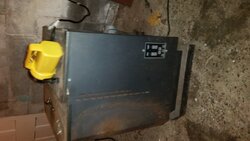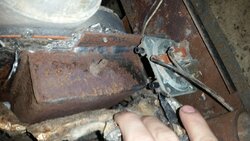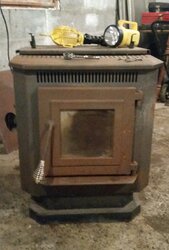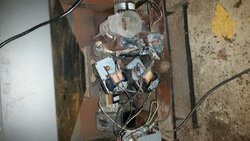Hello fellow members. I am brand new to this forum, and new to owning an old pellet stove.
A couple weeks ago after helping a friend move into a new house, a spotted an old pellet stove in the corner of his old garage, I asked about it, and he said if I can get it out a there for him that I could have it. So, it has officially found a new home after years in a garage. It is an old piece of equipment, but assured me it runs. It isn't in the greatest cosmetic condition, and it's inards look about as expected for its age. I am unsure of the manufacturer name of this stove, but does seem very similar to the Englander 55sph10. Any help identifing this stove is greatly appreciated
I have a small 1.5 stall garage that I would like to install this stove into. After a good cleaning and vacuuming, wE put power to the Stove and it powered up, auger turns, blower works, and sounds decent. However I did notice there was a short vacuum hose that was cracked and plugged solid with soot, and there is what looks like another nipple for another vacuum hose, which is no longer there.
Where does this second hose connect to the stove? And is there a specific type of hose these must be replaced with?
I am a first time stove owner so any tips for things to check prior to installing/running would be greatly appreciated! Here are some picture of the stove, please keep in mind, it's not the prittiest thing you've seen, but a was a free gift
Here are some picture of the stove, please keep in mind, it's not the prittiest thing you've seen, but a was a free gift  Thanks guys and gals
Thanks guys and gals
A couple weeks ago after helping a friend move into a new house, a spotted an old pellet stove in the corner of his old garage, I asked about it, and he said if I can get it out a there for him that I could have it. So, it has officially found a new home after years in a garage. It is an old piece of equipment, but assured me it runs. It isn't in the greatest cosmetic condition, and it's inards look about as expected for its age. I am unsure of the manufacturer name of this stove, but does seem very similar to the Englander 55sph10. Any help identifing this stove is greatly appreciated
I have a small 1.5 stall garage that I would like to install this stove into. After a good cleaning and vacuuming, wE put power to the Stove and it powered up, auger turns, blower works, and sounds decent. However I did notice there was a short vacuum hose that was cracked and plugged solid with soot, and there is what looks like another nipple for another vacuum hose, which is no longer there.
Where does this second hose connect to the stove? And is there a specific type of hose these must be replaced with?
I am a first time stove owner so any tips for things to check prior to installing/running would be greatly appreciated!
 Here are some picture of the stove, please keep in mind, it's not the prittiest thing you've seen, but a was a free gift
Here are some picture of the stove, please keep in mind, it's not the prittiest thing you've seen, but a was a free gift  Thanks guys and gals
Thanks guys and gals





